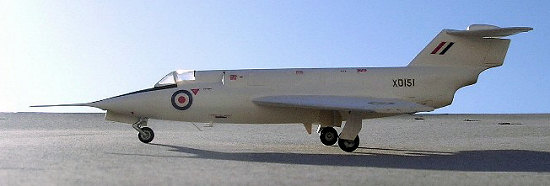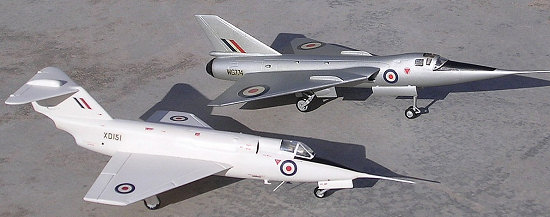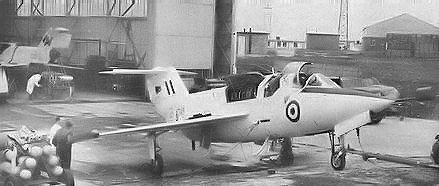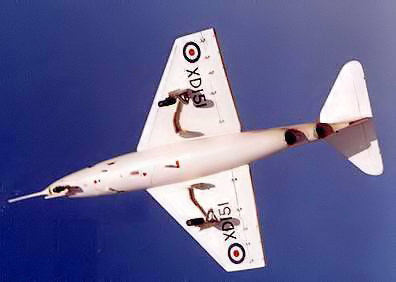
Airfix 1/72 Saunders-Roe SR.53
| KIT #: | ? |
| PRICE: | 50 pence |
| DECALS: | One option |
| REVIEWER: | Carmel J. Attard |
| NOTES: |

| HISTORY |
During 1953, a firm in Britain, Saunders Roe, pursued a concept of a so-called
mixed power interceptor. This was a combination of a turbojet with that of a
rocket power. Thereby using the fuel economy of the turbojet combined with a
higher flight performance of a rocket. In 1953 this project took the form of an
aircraft that carried radar and could carry an infrared guided missile on each
wing tip, the Blue Jay guided missile. The aircraft was to have a powerful DH
Specter rocket engine and a less powerful Armstrong Siddeley Viper turbojet.
Saunders Roe received a contract for three prototypes SR53s. This contract in spite of its steady progress was to be short lived. While the SR53 was on final flight preparations at the A&AEE at Boscombe Down, the Defence Minister Duncan Sandys issued his classic white paper where it was explained that the RAF was unlikely to require any fighter than the Lightning mk1 and so other projects were being shelved. If not cancelled altogether.
In the meantime, on May 16th 1957, John Booth who was S.R. chief test
pilot made the maiden flight of the first SR53 where he reached a speed of Mach
1,33 and recorded a high rate of climb reaching 50,000 feet in one minute. That
same year the SR53 XD145 performed at the SBACC show at Farnborough. After
further flight development and ground handling as well as servicing tests that
were progressing very well indeed, then without the slightest warning, the
entire programme has been cancelled when no further funding was approved. This
was done in spite of great interest expressed by the Luftwaffe and Kriegsmarine
who already had indicated that the British aircraft was their first choice on
technical and o perational
grounds as compared to the F-104 and Mirage III competitors. These have found it
very difficult to understand the termination of a project SR177 that evolved
from the SR53.
perational
grounds as compared to the F-104 and Mirage III competitors. These have found it
very difficult to understand the termination of a project SR177 that evolved
from the SR53.
This was not the end of the story because following the most unbelievable and shortsighted decision; on the 5th of June 1958 Booth was killed while flying the second aircraft XD151 during a take off accident. This along with lack of backing from the government side brought a tragic end to the programme that could have been a world wide success much bigger than that of the F-104 and Mirage III, if only Mr. Duncan Sandys knew how many aircraft of the latter type were to be sold.
SR53 Specification
Length 45’
Height 10’ 10”
Wing area 274 Sq Ft.
Gross Weight: 18,400 lbs
Power plants: One Spectre rocket with full throttle rating of 8,000lbs.
One Armstrong Siddeley Viper turbojet rated at 1,640 lb trust
Performance: Max speed Mach 2 above 35,000’
Acceleration at 50,000’ from Mach 0.9 to Mach 1.4 takes 31 seconds.
| THE KIT |
 The SR53
was released some 40 or so years ago by Airfix and was one of Airfix
exceptionally accurate kits in dimensions measuring 7.5” in overall length and a
wing span of 4.16”. The kit is made up of 26 moulded pieces in white plastic and
one transparent piece for the cockpit canopy. A base stand in transparent
plastic also comes with the kit. A crew figure is also included in the kit bag
as is the custom with Airfix models. The components surface detail is quite good
with flaps and aileron actuators being accurately spaced and moulded in recess
form without being overdone. The inspection-paneling outline located behind the
air intake is slightly on the heavy side.
The SR53
was released some 40 or so years ago by Airfix and was one of Airfix
exceptionally accurate kits in dimensions measuring 7.5” in overall length and a
wing span of 4.16”. The kit is made up of 26 moulded pieces in white plastic and
one transparent piece for the cockpit canopy. A base stand in transparent
plastic also comes with the kit. A crew figure is also included in the kit bag
as is the custom with Airfix models. The components surface detail is quite good
with flaps and aileron actuators being accurately spaced and moulded in recess
form without being overdone. The inspection-paneling outline located behind the
air intake is slightly on the heavy side.
The instruction sheet is the familiar type of Airfix early kits, showing exploded view in black outline, shown in numerical order to indicate steps of construction with assembly detail being broken down in three construction stages. Plan and side views help with placing the decals in the correct positions. The artwork provided with the instructions is exceptionally good and acts as a source of reference when it comes to add the markings to the finished model; or the shape of engine outlets; adding the various antennae, whip aerials etc.
| CONSTRUCTION |
Reference to photos of the actual aircraft will clearly indicate that the
shape of the undercarriage doors need to be slightly altered and the section
thickness reduced by half. If left open, the air brakes parts No 21 and 22 would
also need thinning down and some detail added to the interior. Detail to cockpit
office and wheel wells are practically non existent which was then th e
order of the day. It is therefore to conduct some research work to rectify these
areas which are rather small. The under fuselage slot which is intended to take
the stand that comes with the kit is blanked with putty and sanded smooth. The
pilot figure needed some trimming and an easy way to improve on an otherwise
plain ejection seat was to obtain an equivalent from after market supplies or
rebuild detail to existing one upon reference to photos of the type used.
e
order of the day. It is therefore to conduct some research work to rectify these
areas which are rather small. The under fuselage slot which is intended to take
the stand that comes with the kit is blanked with putty and sanded smooth. The
pilot figure needed some trimming and an easy way to improve on an otherwise
plain ejection seat was to obtain an equivalent from after market supplies or
rebuild detail to existing one upon reference to photos of the type used.
An overall comment is that the kit contained a quantity of flash that needed to be removed with a little effort. The wing mounted Firestreak shaped missiles which were then known as Blue Jay needs to be replaced with more recent shapes or otherwise if one wants to use the missiles supplied these have to have new fins as the ones with the kit are on the thick side. I have preferred to leave the missiles off from the tops. To play safe I added nose weight to make sure that the kit would balance on its nose. This was encased to the nose cone area. Another observation is that one could see through the other end if one looks down the air intakes. This was interrupted using a blanking piece across during early construction. This area inside the fuselage was carefully painted matt black.
| COLORS & MARKINGS |
 Having
all the parting lines and imperfections attended to so that a smooth surface
finish is obtained on a streamlined dynamic design using putty followed by
sanding smooth, the kit was then given a coat of semi matt Humbrol white coat.
After allowing time to dry the surface was given a smooth sanding with wet and
dry and given the final semi matt coat of white overall finish. Anti glare panel
ahead of canopy was painted matt black.
Having
all the parting lines and imperfections attended to so that a smooth surface
finish is obtained on a streamlined dynamic design using putty followed by
sanding smooth, the kit was then given a coat of semi matt Humbrol white coat.
After allowing time to dry the surface was given a smooth sanding with wet and
dry and given the final semi matt coat of white overall finish. Anti glare panel
ahead of canopy was painted matt black.
The decal
sheet had a yellowish carrier film and this could be trimmed with a sharp
modeling knife. There were 14 decal items besides the name of aircraft. In my
case the decal only served to obtain the size of lettering and roundels to use.
The Airfix kit serial was XD145, which is the aircraft that survived to this
day.  I preferred to make mine
to represent XD151. As for the roundels and markings I used ones from Model
Decal sheets. It is interesting to note that at one time both prototypes were
undergoing intensive tests at the same SR facilities, standing only a few yards
apart.
I preferred to make mine
to represent XD151. As for the roundels and markings I used ones from Model
Decal sheets. It is interesting to note that at one time both prototypes were
undergoing intensive tests at the same SR facilities, standing only a few yards
apart.
| CONCLUSIONS |
The
overall semi matt white finish showed the delicate characteristic features of
the SR53 and with a most pleasing effect when the fine extra detail was added to
the outside. The kit filled an interim gap when the RAF was still looking for a
new fighter that was required to be fast in speed and with a high rate of climb.
The scale model of the SR53 makes a good contrast when placed next to other
research and development aircraft as th e Fairey Delta 2 (Frog) and the TSR2
(Airfix). These were designs well ahead of their time. One still wonders what it
would have been like if aircraft like the SR53 and TSR2 would have made it into
production and active service with the RAF and other European forces as was
originally intended to.
e Fairey Delta 2 (Frog) and the TSR2
(Airfix). These were designs well ahead of their time. One still wonders what it
would have been like if aircraft like the SR53 and TSR2 would have made it into
production and active service with the RAF and other European forces as was
originally intended to.
| REFERENCES |
Air Pictorial issues.
June 2007
If you would like your product reviewed fairly and fairly quickly, please contact the editor or see other details in the Note to Contributors.